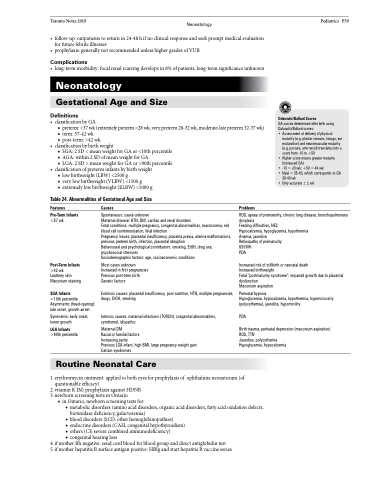Page 1093 - TNFlipTest
P. 1093
Toronto Notes 2019 Neonatology
• follow-up:outpatientstoreturnin24-48hifnoclinicalresponseandseekpromptmedicalevaluation for future febrile illnesses
• prophylaxis:generallynotrecommendedunlesshighergradesofVUR
Complications
• long-termmorbidity:focalrenalscarringdevelopsin8%ofpatients;long-termsignificanceunknown
Neonatology
Gestational Age and Size
Definitions
• classificationbyGA
■ preterm:<37wk(extremelypreterm<28wk,verypreterm28-32wk,moderate-latepreterm32-37wk) ■ term: 37-42 wk
■ post-term: >42 wk
Pediatrics P59
• classificationbybirthweight
■ SGA: 2 SD < mean weight for GA or <10th percentile ■ AGA: within 2 SD of mean weight for GA
■ LGA: 2 SD > mean weight for GA or >90th percentile
• classificationofpreterminfantsbybirthweight ■ low birthweight (LBW) <2500 g
■ very low birthweight (VLBW) <1500 g
■ extremely low birthweight (ELBW) <1000 g
Table 24. Abnormalities of Gestational Age and Size
Dubowitz/Ballard Scores
GA can be determined after birth using Dubowitz/Ballard scores:
• Assessment at delivery of physical
maturity (e.g. plantar creases, lanugo, ear maturation) and neuromuscular maturity (e.g. posture, arm recoil) translates into a score from -10 to +50
• Higher score means greater maturity (increased GA)
• -10=20wk;+50=44wk
• Ideal = 35-40, which corresponds to GA
38-40 wk
• Only accurate ± 2 wk
Features
Pre-Term Infants
<37 wk
Post-Term Infants
>42 wk
Leathery skin Meconium staining
SGA Infants
<10th percentile Asymmetric (head-sparing): late onset, growth arrest
Symmetric: early onset, lower growth
LGA Infants
>90th percentile
Causes
Spontaneous: cause unknown
Maternal disease: HTN, DM, cardiac and renal disorders
Fetal conditions: multiple pregnancy, congenital abnormalities, macrosomia, red blood cell isoimmunization, fetal infection
Pregnancy issues: placental insufficiency, placenta previa, uterine malformations, previous preterm birth, infection, placental abruption
Behavioural and psychological contributors: smoking, EtOH, drug use, psychosocial stressors
Sociodemographic factors: age, socioeconomic conditions
Most cases unknown Increased in first pregnancies Previous post-term birth Genetic factors
Extrinsic causes: placental insufficiency, poor nutrition, HTN, multiple pregnancies, drugs, EtOH, smoking
Intrinsic causes: maternal infections (TORCH), congenital abnormalities, syndromal, idiopathic
Maternal DM
Racial or familial factors
Increasing parity
Previous LGA infant, high BMI, large pregnancy weight gain Certain syndromes
Problems
RDS, apnea of prematurity, chronic lung disease, bronchopulmonary dysplasia
Feeding difficulties, NEC
Hypocalcemia, hypoglycemia, hypothermia
Anemia, jaundice Retinopathy of prematurity ICH/IVH
PDA
Increased risk of stillbirth or neonatal death
Increased birthweight
Fetal “postmaturity syndrome”: impaired growth due to placental dysfunction
Meconium aspiration
Perinatal hypoxia
Hypoglycemia, hypocalcemia, hypothermia, hyperviscosity (polycythemia), jaundice, hypomotility
PDA
Birth trauma, perinatal depression (meconium aspiration) RDS, TTN
Jaundice, polycythemia
Hypoglycemia, hypocalcemia
Routine Neonatal Care
1. erythromycin ointment: applied to both eyes for prophylaxis of ophthalmia neonatorum (of questionable efficacy)
2. vitamin K IM: prophylaxis against HDNB
3. newborn screening tests in Ontario
■ in Ontario, newborn screening tests for:
◆ metabolic disorders (amino acid disorders, organic acid disorders, fatty acid oxidation defects,
biotinidase deficiency, galactosemia)
◆ blood disorders (SCD, other hemoglobinopathies)
◆ endocrine disorders (CAH, congenital hypothyroidism)
◆ others (CF, severe combined immunodeficiency) ◆ congenital hearing loss
4. if mother Rh negative: send cord blood for blood group and direct antiglobulin test
5. if mother hepatitis B surface antigen positive: HBIg and start hepatitis B vaccine series


